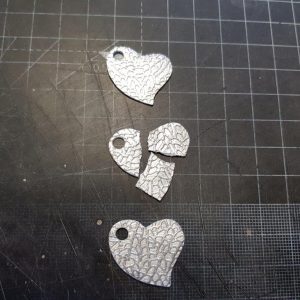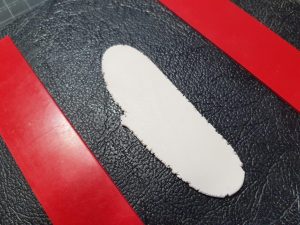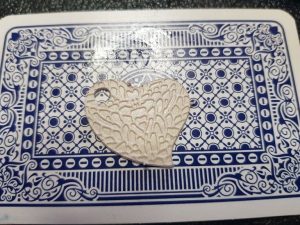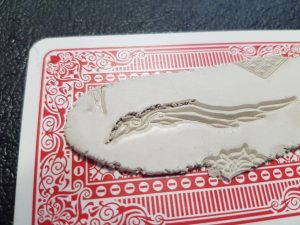FS999
My adventures and findings with different brands of Silver Clay – this blog talks about FS999.
Recently, I gave myself a wee challenge. I was going to push past my comfortable relationship with the well-known brands of PMC and ACS and see what the other brands of silver clay were like. I have already blogged about FYI 999 and Prometheus 999 and you can have a look at those bloges by clicking on the links.
This blog is all about my experiences with FS999. It’s the sister product to EZ960 made and supplied by Cool Tools in the US. I did get it from the US along with some other lovely goodies from that excellent store – but I did get stung with quite a sizable import duty when it arrived, which is the price you pay when you import from the US unfortunately.
Initial Impressions
I was excited to try this clay – I have heard lots of great things about EZ960 (and my experiences with this clay will be covered in a later blog), so had the impression that the FS999 would be just as good.
When I opened the packet of the 50g bag, I found 2 bags of 25g. I love that! Aida do it with their bigger bags of ACS and I just find that somehow reassuring…that the whole bag of clay isn’t opened and that you don’t have to go straight on and use it all in one or two sittings – NOT that I do that all the time! Have you checked out my blog about storing your clay?
I rolled it between my hands and it felt really nice. Soft and squishy, not sticky at all and I thought I was off to a good start. However, that’s where the good experience ended.
Working with FS999
When I rolled it out onto my mat, it started to ‘fray’ at the edges as you can see in the picture. I carried on and textured it – it took texture very well and cut out a heart shape with a template and a needle tool. I found this annoying, because when I was cutting with my super sharp tool – the edges frayed there too. This should NOT happen with a freshly opened clay. I expect this when the clay has been opened and rolled, rerolled and rolled again and even then, it didn’t seem to be so noticeable. When I cut the hole with a cutter, it was a clean cut.
When I worked some more with the clay, I felt it was getting ‘tired’ very quickly and even when I added extra water to the surface, it still didn’t seem to recover very well. It felt grainy somehow and after using it my fingers felt slightly chalky.
I have to confess I didn’t read the firing instructions (which I will discuss a bit later) expecting it to be like any other Fine Silver clay on the market out there – i.e. it has a range of different temperatures it can be fired at, so I made a setting for a glass cabochon. Just because that’s what I was doing that day 😊. Turns out in the suggestions for firing, it says the lowest temperature you can fire at is 788oC (1450oF) for 4 hours. No good for glass. But I only realised this *after* making my piece!
I also made bails for my pieces, involved it being bent over a straw to dry. The FS999 did not like this one bit. It was cracking and unyielding, however, I persevered, adding more moisture as I rolled out again and managed to get a bail that wasn’t too bad.
When the pieces are dry, I found them to be quite flexible – not as flexible as PMC Flex, but bendy – see the short video clip. I got a bit of a surprise since I wasn’t expecting that so sanding and finishing – especially on some of my more complicated pieces was challenging.
Firing FS999
Firing was straight forward. There is a firing schedule given with each bag of clay
It is:
1650oF / 900oC – 30 mins – 2 hrs (depending on the size of your piece)
1600oF / 871oC – I hour
1550oF / 843oC – 2 hours
1450oF / 788oC – 4 hours
Now since the difference in temperature is so little between each of the breaks and the firing time goes up quite a lot, I wasn’t sure why or to what benefit each of these different firings meant.

Firing examples Top – Kiln fired (900oC for 2 hrs) Middle Kiln fired 700oC for 30 mins Bottom Handfired for 5 mins
So I just kept things simple.
I fired 3 test pieces. One at 900oC (1650oF) for 2 hours like I do with most of my silver clay. Once at 700oC for 30 minutes – this was the glass firing schedule and I wanted to see if I could fire this clay at that temperature and I handfired one.
The pieces fired at 900oC fired well and were strong – so no issues there.
The glass pieces I fired at 700oC for 30 minutes *looked* OK – but the test piece, my heart, broke when I tried to bend it. Quite clearly, the piece hadn’t sintered. I’m guessing this means that the glass pieces also didn’t sinter although it’s harder to break them. I guess this is unsurprising since nowhere on the instructions did it suggest firing at this temperature for this time!
My handfired piece was fired for 5 minutes as per the instructions and fared well. It felt reasonably strong (as strong as I would expect a handfired piece to be) and didn’t snap like the piece fired at 700oC for 30 minutes.
You can see the differences in shrinkage between the top kiln fired piece and the bottom handfired piece. The piece in the middle was fired at 700oC for 30 minutes – hence the break.
And for those of you who were wondering about how the pieces fared with the glass… well they survived, but I wouldn’t trust them since the test piece that I fired at the same temperature broke. My lesson? Read the firing instructions BEFORE designing a piece!
All pieces polished up really well afterwards, so there was no indication of how tricky this clay was to work with!
Storing FS999 and its longevity
I didn’t use all the clay at once and popped the rest in an airtight container with a baby wipe for company (this is my way of keeping moisture in the pot). But when I came back to use it – I made a toggle clasp from a lovely but unfortunately discontinued Dynasty texture sheet which involved a lot of challenging cutting out, the clay became quickly unusable.
And I mean unusable. It didn’t survive being kept in the pot I described for a couple of days. It actually started to crumble on me!! Crumble! Like when you’ve overworked pastry and it won’t stick together any longer. I was really annoyed with it and put it in my waste pot for reconstituting at a later date. I would say it was roughly 15g of clay!
Conclusion
I am sure you know what I am going to say now……I wouldn’t recommend this clay to my students. Especially beginners. It’s too challenging to work with and it gives a bad impression of what silver clay can do. I have since seen reviews and questions about it in one of the metal clay Facebook groups I am a member of and it seems I am not the only one to experience these issues. However, unlike them, because I was based in the UK, I couldn’t easily return the product.
There are better fine silver clays out there. Try them first.
What has been your experience with FS999? Feel free to comment below.
Until next time, happy claying!
Emma x











Thanks for all that info – very useful.
I must admit to being a coward when it comes to trying out new clays.
Thanks for the blogs, they are really useful.
Really interesting to see the results. A bit sad that you were stung both with custom price and how the product worked.
I just bought FS999 and I fired it tonight in Cocoanut Carbon at 1650 for 3 hours as recommended and the didn’t even harden they were like plaster and crumbled!
Hi Michelle
I don’t think that fine silver needs to be fired in carbon – it needs to be fired in the open to ensure it can sinter properly. Carbon is only used for Sterling Silver (PMC) and base metal clays.
Try again without carbon and see how you get on, good luck!
With best wishes
Emma
I´m using it for the fisrt time for your pendant challenge now and as I only have a ultralite kiln I´m on my third firing because it´s not sintered at all with the other two, this time I´m going to fire it for 4h with ultralite kiln at full temperature, I hope it works.
When you working with it, it feels so gummy and once dry it´s very hard to sand.
I don´t like it at all, and as you said I don´t recommend it.
Hi! I have been using PMC3 with great results in an ultralite kiln, so I’ve ventured to try FS 999. I fired for 2 hours at 1650.
It never sintered. When I crumbled it up there were small sintered pieces. It was disappointing, but a learning experience. I’m just not sure where to go from here other than back to PMC3!
Hey Gina
FS999 is notoriously tricky to fire and it’s much easier to fire in a ‘tradional’ kiln. If you’re looking for a new clay to try – the try PMC Flex or Art Clay Silver (in the silver packet) both are fine silver and have a more reliable firing record.
Hope that helps x
As a newbie to all the different clays, I am so grateful for this information as it will save me frustration, time and money! Thank you!
Hey Beverly
I am so pleased it helped you! Did you get your hand on the Beginner’s Guide too? that might help even more xx